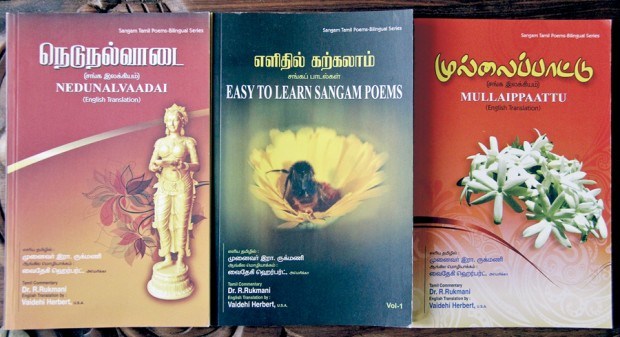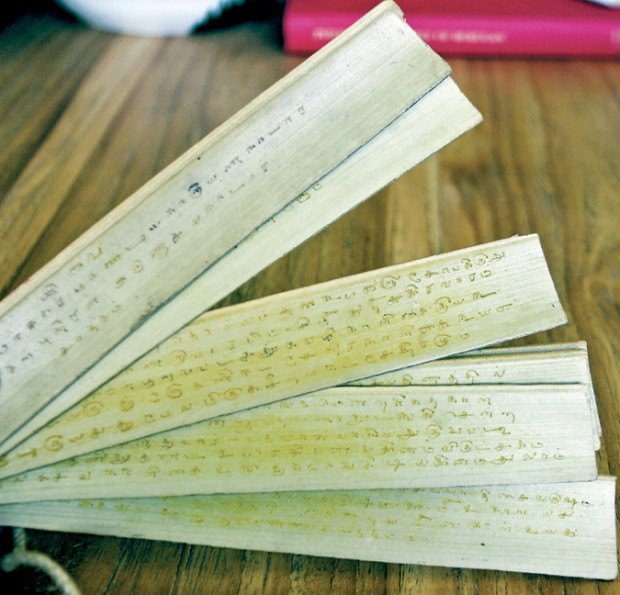Vaidehi “Vi” Herbert will tell you she is not a poet or a language scholar. She is simply passionate and disciplined.
Herbert has dedicated the last three years to studying Tamil, one of the classical languages of India, and translating hundreds of ancient Sangam poems from her second language into English. She is originally from Tamil Nadu, located in southern India, where the language has official status.
“No other scholar in Tamil Nadu or from other countries have translated this volume of literature,” Dr. Rukmani Ramachandran, Herbert’s teacher and an assistant professor of Tamil at Queen Mary’s College in Chennai, wrote in an email. “Her passionate love for Sangam poetry knows no bounds.”
The Sangam genre of poetry dates from approximately 300 B.C. to 300 A.D. There are 18 Sangam Tamil books containing 2,381 poems written by 473 poets, 102 of whom remain unknown.
So far, Herbert has translated approximately 1,800 of those poems into English, with plans to complete the remainder over the next year. She has co-authored three books with Rukmani, with five more in the works and has set up more than 20 websites dedicated to teaching Sangam.
“This is something I am doing with passion,” she said. “I spend, on average, 13 to 15 hours per day.”
Herbert’s goal is simple — to share the beautiful poetry with the world.
In her “Introduction to Sangam Literature,” Herbert writes that the poems are “delightful in language and thought, scant in lines but rich in content and filled with human emotions intertwined with the natural elements found in the Tamil country.”
To put it simply, Sangam is “ancient, secular landscape and love poetry,” Herbert says.
“About 75 percent of the literature is love and nature poetry,” she said. “In every poem plants, trees, flowers, animals, mountains, streams, ocean, etc. are used as metaphors and similes. Human emotions are brought out through the nature of nature.”
The poems are divided into five different landscapes — mountainous regions, forests, agricultural land, coastal regions and deserts — with different emotions attached to each. Herbert says that the tropical Tamil landscapes described are surprisingly similar to those found here on Kaua‘i, making the poems that much more special.
“This is what I grew up with,” she said. “It’s so Kaua‘i.”
The Sangam poems, which were originally passed down orally before being etched on palm manuscripts, remained lost for nearly 1,000 years. They were rediscovered in Hindu monasteries during the late-19th century by scholars U.V. Swaminatha Iyer and C.W. Thamotharam Pillai.
It is from this story that Herbert draws her motivation.
“My first goal is to teach Sangam Tamil to the Tamil people, who have been denied this ability, since learning Sangam poetry by the average Tamil has been perceived as almost impossible and belonging to the privileged Tamil scholars, both within India and outside India,” Herbert said. “Also, I think western students of Tamil can use my books to learn these poems.”
Herbert began studying Tamil with Rukmani three years ago and has been translating ever since.
“I (first) taught her a long poem from the 2nd century that has 103 lines,” Rukmani wrote. “She learned it in just five days, even though she had to learn most of the words.”
Herbert went on to learn about Sangam Tamil poetry through the books of foreign Tamil scholars including Dr. Takanobu Takahashi of Japan, Dr. George Hart of the United States, Dr. Kamil Zvelebil of Czechoslovakia, Dr. Ralston Marr of the United Kingdom and A.K. Ramanujan, the Tamil scholar who introduced Sangam poetry to the United States, according to Rukmani.
Herbert says her ancestors divided this body of literature into two parts, the internal and the external.
“‘Internal’ meaning love in all phases between a man and a woman, and ‘external’ meaning what happened with kings, wars and other general issues,” she said. “The metaphors and similes offer many levels of hidden meanings.”
Most important, to both Herbert as well as scholars around the world, is her translations keep true to the originals.
In an email to Herbert, Takahashi wrote, “Your translation of NeTunalvaatai (one particular poem) is very good. It is accurate and readable. Especially, it is amazing that the word/sentence order of your translation is almost the same with the Tamil text, although the English word order is very different from the Tamil one.”
In his back-cover review of her books, Hart, a professor of Tamil at the University of California, Berkeley, writes that he is delighted to recommend the work of Herbert and Rukmani.
“Rukmani’s careful commentaries are simply to follow, and Veidehi’s translations are easy to read, accurate and graceful,” he wrote. “Through the work of these devotees of Tamil literature, Tamils will find that the poems of the Sangam age are available to them in a form that will help them realize their ancient heritage and bring them great pleasure.”
Stephanie Misaki Whiting, who lives in Princeville, is the editor of all Herbert’s poems and has learned about the Tamil culture from her.
“Reading and editing Vi’s translations of Sangam poetry has added more richness and depth to my appreciation of the Tamil people and their history,” she said. “Sangam poems, apart from their cultural context, speak of love and human relations in all their intricacies and in this way, they are timeless.”
In the future, Herbert hopes to take some of the Sangam poems to Broadway.
“They are beautiful stories,” she said. “I just have to reach the right people.”
Anyone interested in learning more about Sangam poetry is encouraged to visit Herbert’s main websites at http://sangampoemsinenglish.wordpress.com and www.learnsangamtamil.com. She can also be contacted by email at kavini100@gmail.com.
Originally from Tamil Nadu, Herbert moved to Kaua‘i’s North Shore 10 years ago after nearly 30 years in California. She and her husband, Charlie, live near Kilauea.
Kurunthokai 3,
Thevakulathar, Kurinji Thinai
What the heroine said about
her love for the hero, as he listened
nearby …
Larger than the earth,
higher than the sky,
and harder to fathom
than the ocean,
is my love for the man
from the country whose slopes
have black-stalked kurinji flowers
which yield rich honey.
Poem Explanation: This is the only poem written by this poet. Muthal is the land, sky, mountain and ocean. Karu elements are honey and kurinji flowers. Uri is the love feeling that the heroine has for the hero. The heroine is very happy about her love for the hero.






